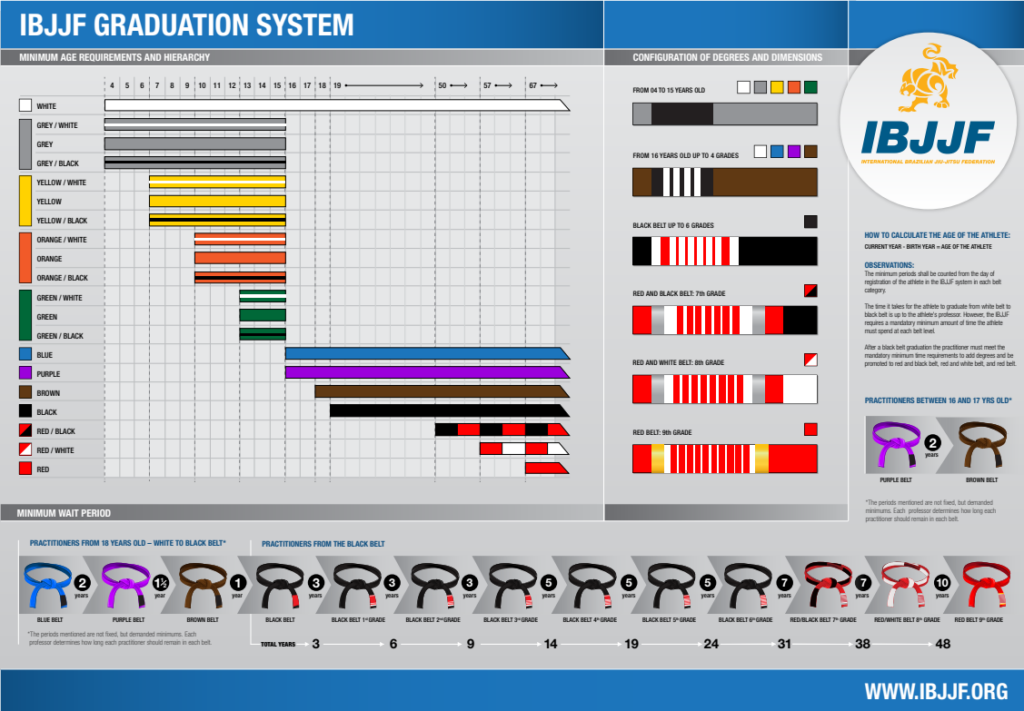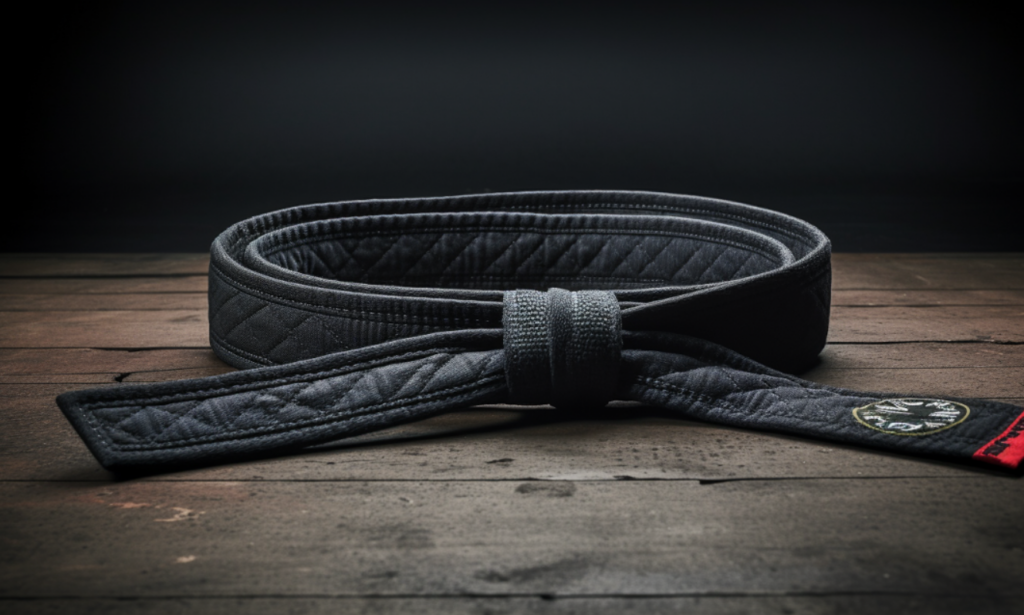
Introduction
As an experienced practitioner of Brazilian Jiu Jitsu, I have gained a thorough understanding of the BJJ belt system. In its most basic form, the belt system is a ranking system used to measure the level of skill and knowledge of a practitioner. The belts are color-coded, ranging from white to black, with each belt representing a different level of proficiency. Kids and Adults have a different system, which we will explore as well.
Learning BJJ is much like learning a language. A foreigner in a new country is lost and at the mercy of the native speakers, gently being ushered along or perhaps being easily taken advantage of.
Brief History of the BJJ Belt System

The BJJ belt system was first introduced by the Gracie family in the mid to late 20th century. At first, the Gracies were hesitant to introduce a belt system, but saw the advantages in marketability it offered. Over time, the BJJ belt system evolved to become the system we know today, with the final progression being white, blue, purple, brown, and black.
Kid's Belt System
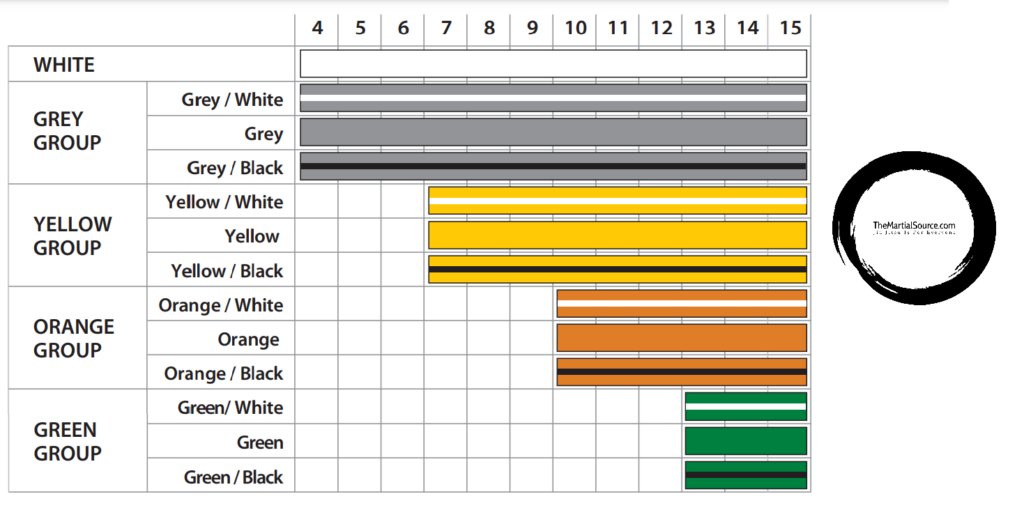
The kids’ belt system is distinct from adults, structured to recognize incremental progress and maintain motivation. Beginning with the white belt, children progress through a series of colors: grey, yellow, orange, and green. Each belt, except white, has further sub-divisions marked by white or black horizontal stripes, allowing for regular promotions. These belts not only signify skill but also maturity and time spent training. Instructors emphasize technique, discipline, and respect throughout a child’s BJJ journey. As kids approach their teens, they transition to the adult belt system. Typically, an adult blue belt is available at the age of 16. This structured hierarchy provides clarity, promotes perseverance, and celebrates small achievements, fostering a deep love for the sport.
Breaking Down the BJJ Belt System
White Belt

In order to earn a white belt in BJJ, practitioners must typically demonstrate basic knowledge of the fundamentals of the art, such as the various positions, transitions, and techniques. This can be done through drills, techniques, and sparring. The white belt curriculum generally focuses on the basics of BJJ, including stance, posture, guard passes, escapes, and introductory submissions.
Applying the metaphor of language, white belt is when you learn your vocabulary. Each move becomes a word you are learning. You must learn proper usage, application and pronunciation before anything else. Your conversations are brutish and rudimentary, but you can get by in an emergency.
Blue Belt
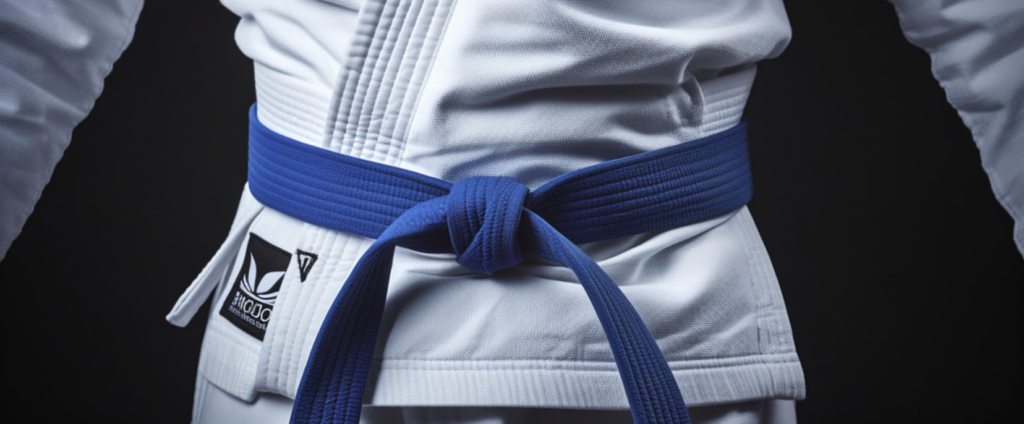
In order to earn a blue belt in BJJ, practitioners must demonstrate a deeper understanding of the fundamentals, including the ability to consistently apply them in sparring. It typically takes practitioners between 12-24 months to earn a blue belt. This timeframe can vary depending on the individual’s experience and skill level. The blue belt curriculum does not expand much beyond the fundamentals, but focuses on transitioning and stringing techniques together.
In “conversation” the blue belt is learning how to properly use specific phrases and sentences to communicate. The blue belt’s vocabulary is significant enough that they can more effectively communicate on a basic level.
Purple Belt
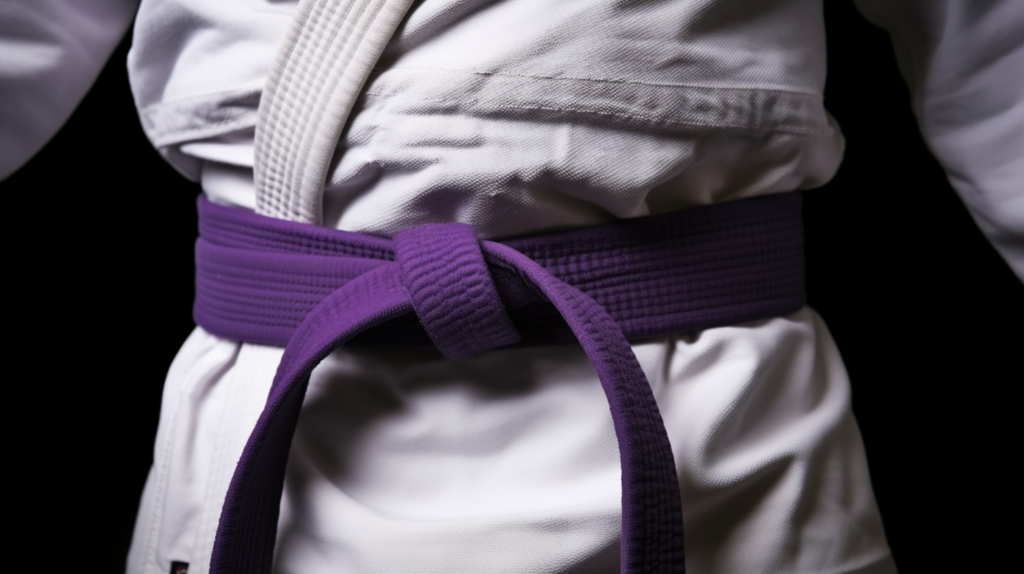
To earn a purple belt in BJJ, practitioners must demonstrate a mastery of the fundamentals and have a more refined understanding of the art. It typically takes practitioners between 2-3 years to earn a purple belt. This timeframe can vary depending on the individual’s experience and skill level. The purple belt curriculum focuses on the refinement of techniques, as well as the development of new, more advanced techniques such as leg attacks and athletic guard pass sequences.
Following the language model, the purple belt is fully functional in language, but not yet fluent. A purple belt is able to write original essays and research papers, as their style of speaking is truly taking shape. If you’re looking for more information on the BJJ Purple belt, check out this article.
Brown Belt
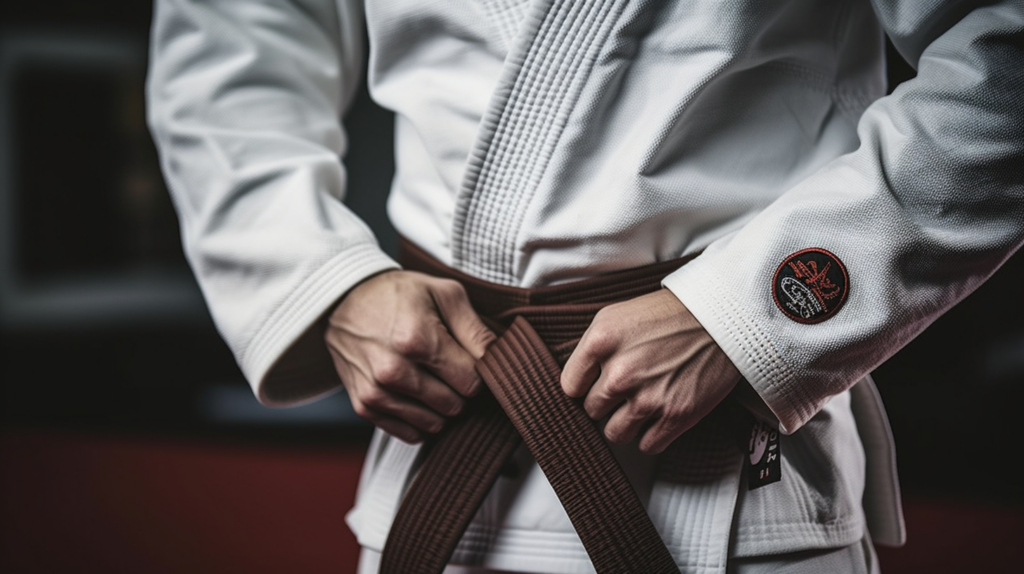
To attain a brown belt in BJJ, practitioners are expected to exhibit profound mastery of the discipline, coupled with an in-depth comprehension of its techniques and underlying principles. The curriculum for the brown belt emphasizes technical excellence and the cultivation of advanced strategies. On average, practitioners may require at leas a year at purple belt, but 2-3 years is more common.
Going back to our metaphor, the brown belt is now considered to be fluent in their new language, capable of composing extended thesis level writing and thought. The brown belt is able to maintain fundamental accuracy, while adding their own “accent” to what is fundamentally correct technique.
Black Belt

To achieve a black belt in BJJ, practitioners must not only possess a profound understanding of the discipline but also demonstrate the aptitude to impart this knowledge to others. The journey to a black belt generally spans at least 5 years, although the accepted average is 10 or more years.
A Brazilian Jiu Jitsu black belt is now composing poetry. The jiu jitsu they demonstrate shows an elegance and originality that can only be compared to sophisticated prose, and they do so with ease.
Variations in the system
In addition to the traditional BJJ belt system, some academies and organizations have created slight variations.
White belts with blue ribbons
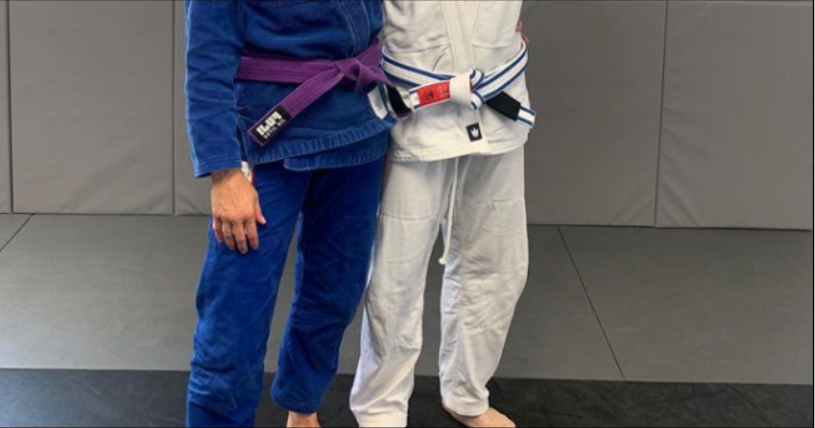
Some academies, especially those of Renzo Gracie lineage will not offer stripes on a white belt, but will promote to a new belt with blue ribbons, one ribbon for each stripe.
The Importance of the BJJ Belt System
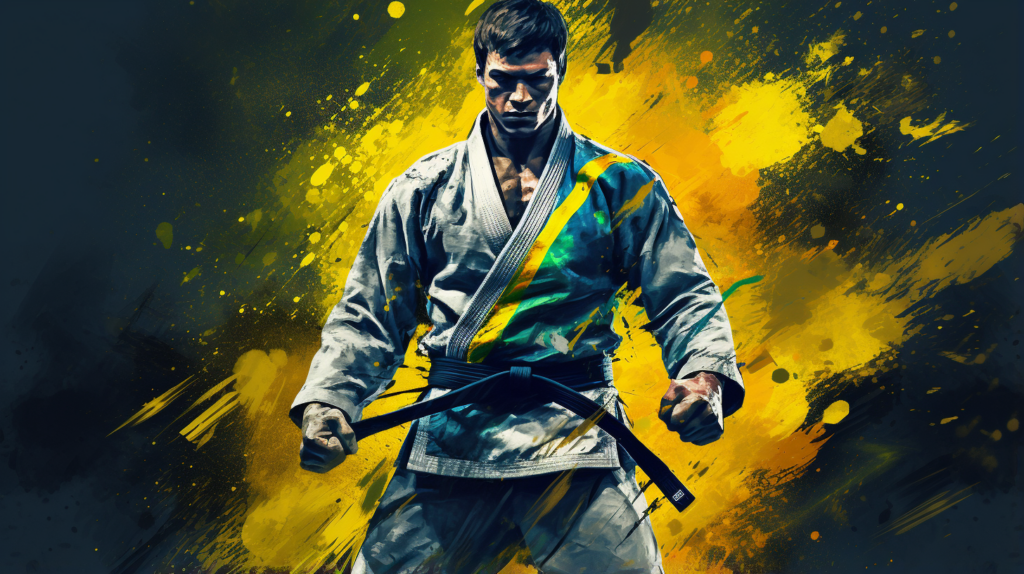
With extensive experience in Brazilian Jiu-Jitsu, I deeply appreciate the pivotal role the belt system plays in our martial discipline. In this segment, I will delve into the belt system’s importance, touching upon its influence on goal-setting, motivation, skill evaluation, acknowledgment, and the preservation of time-honored traditions and standards.
Goals and Motiviation
The BJJ belt system offers practitioners a structured pathway for advancement and goal realization. Each belt represents a significant milestone, bestowing upon practitioners a tangible sense of achievement and invigorating their commitment to the art. Speaking from personal experience, I can attest to the profound motivation and fulfillment derived from climbing the ranks, especially early in my career.
Assessment and Skill Level
The BJJ belt system is a potent tool for gauging skill proficiency. Through the rigorous process pressure testing, instructors can track a student’s advancement, ensuring the absorption of essential techniques and concepts. Having undergone hours upon hours of live rolling to achieve my own belt promotions, I recognize its intrinsic value in appraising skill and awarding belts to those who manifest true evolution in BJJ.
Recognition
The belt system also serves as a way of recognizing practitioners for their hard work and dedication to BJJ. As a casual instructor, I take pride in watching students level up. As a BJJ student, I am not ashamed to say that the validation and recognition associated with belt promotions to be both encouraging and rewarding.
Maintaining Traditions and Standards
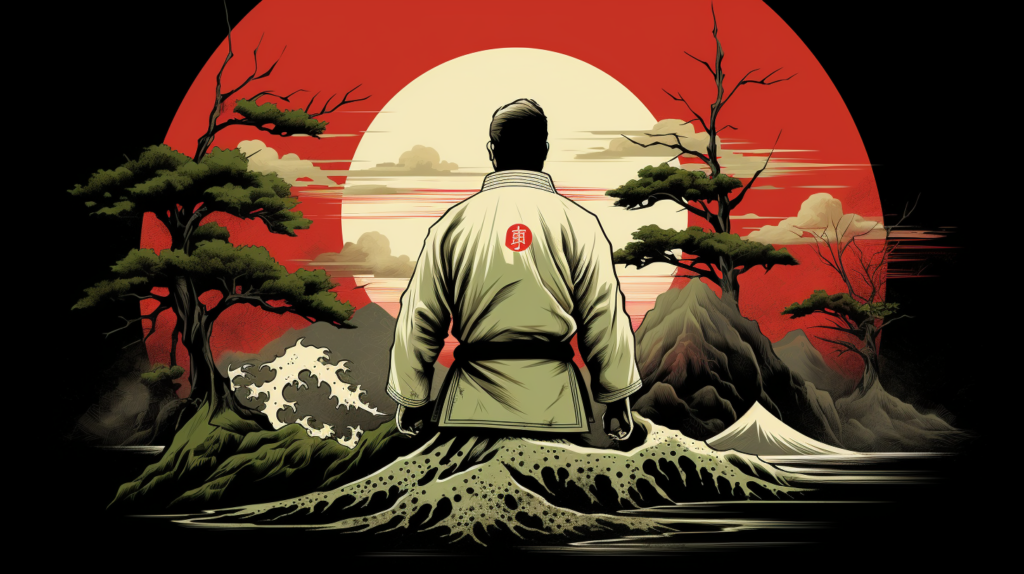
Finally, the BJJ belt system helps to ensure the traditions and standards of our martial art are maintained. By requiring practitioners to demonstrate proficiency of techniques and principles before being awarded a higher belt, instructors can ensure the quality of BJJ instruction is upheld. The belt system is an effective way of ensuring the traditions and standards of BJJ are maintained and passed down to future generations of practitioners.
Challenges With the BJJ Belt System
Having trained and competed in Brazilian Jiu Jitsu for several years, I have come to understand the intricacies of the BJJ belt system. While the belt system can be an effective way to measure a person’s skill level and progress, it can also be subject to various challenges. Here, I will discuss three of the main challenges with the BJJ belt system: belt promotions based on politics or favoritism, disagreements over belt promotions, and belt factory schools.
Belt Promotions Based On Politics or Favoritisim
In the BJJ community, there have been instances of belt promotions based on politics or favoritism rather than on the merits of the student’s skill level. This can be a tricky issue, as it can cause frustration among students who feel they have not been fairly evaluated. As a BJJ practitioner, it is important to be aware of this dynamic, and to remember that belt promotions should be determined by the student’s skill level, not by any external factors.
However, remember that someone else’s belt promotion has nothing to do with you. Your progress is yours, and the advancements of other students, regardless of motivation does not effect your progress as a practitioner.
Disagreements Over Belt Promotions
At times, there can be disagreements over who should receive a belt promotion. This is often the case in larger BJJ schools, where there are multiple instructors who may have different opinions on whether a student is ready for a promotion. As a BJJ student, it is important to understand that belt promotions should be based on the student’s skill level and performance, rather than on the opinion of any one instructor.
Frankly, the student’s performance on the mats should speak for itself. If the student is resistant to change, this will be the final obstacle that must be overcome
McDojos and Belt Factories

In recent years, there has been an increase in what are known as “belt factory schools,” which are BJJ schools that promote students to higher belts too quickly. This can be a problem, as it devalues the belt system and can lead to students receiving belts that they are not yet prepared for. It is important to ensure that you are training at a school that follows a fair and consistent belt promotion system.
Conclusion
Maintaining Standards
The BJJ Belt System is an important part of Brazilian Jiu-Jitsu, as it provides practitioners with an objective measure of their progress and encourages them to strive for improvement. Additionally, the system helps to maintain standards within the sport, as it ensures that only those who meet the criteria for promotion are awarded higher belts.
The Future of the Belt System
The BJJ Belt System is an evolving system, and it is constantly being adapted to reflect the changing landscape of Brazilian Jiu-Jitsu. . As the sport continues to evolve, so too will the BJJ Belt System, ensuring that it remains relevant and reflective of the needs of Jiu-Jitsu practitioners in the 21st century.
I hope that this overview has provided you with a better understanding of the system and the importance of maintaining standards within the sport.
